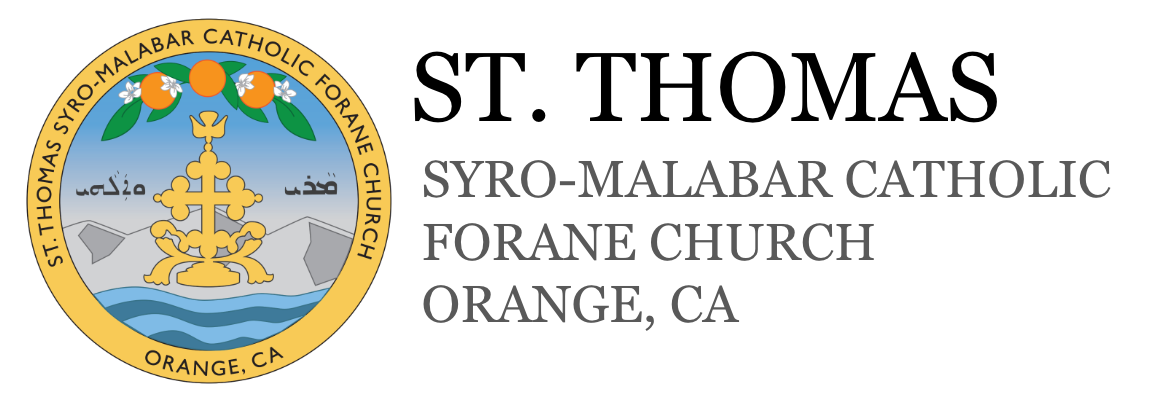The Syro-Malabar Church is an Apostolic Church which traces its origin to the Apostolate of St. Thomas who, according to the tradition, landed at Cranganore in 52 AD and founded seven Christian communities at Palayur, Cranganore, Kokkamangalam, Kottakavu (Parur), Quilon, Niranam, and Chayal. It is one of the 22 sui iuris Oriental Churches in Catholic Communion with its own particular characteristics expressed in worship, spirituality, theology and disciplinary laws. The early Christian community in India was known as St. Thomas Christians. In the course of history, this Church entered into life-relation with the Christian communities which came to be known as the East Syrian Church. This relationship made the Thomas Christians share the liturgical, spiritual and other ecclesiastical traditions with the East Syrian Church. At the same time St. Thomas Christians kept their distinctive character especially in Church administration and socio-cultural and ascetic-spiritual life. In the 16th Century with the arrival of the Portuguese, a new era began in the life of this Church, i.e., the Latinization of its liturgy and the efforts of the St. Thomas Christians to free itself from this situation. In the Nineteenth Century, this Church was designated as the Syro-Malabar Church in the documents from the Roman Curia under which name it is known today
In 1887 the St. Thomas Christians were re-organized under two Vicariates, Kottayam and Trichur. In 1896, when the St. Thomas Christians obtained bishops of their own rite and nation, they were further reorganized into three Vicariates, Trichur, Ernakulam, and Changanacherry. On December 21, 1923, the Syro-Malabar Hierarchy was established with Ernakulam as the Metropolitan See and Trichur and Changanacherry and Kottayam (established in 1911 for the Southists) as suffragans. In 1956 Changanacherry was raised to the status of a Metropolitan See.
On December 16, 1992, Pope John Paul II raised the Syro-Malabar Church to the status of Major Archiepiscopal sui iuris Church with the title of Ernakulam-Angamaly. Mar Antony Paidyara, the then Metropolitan of Ernakulam was appointed its Major Archbishop with Mar Abraham Kattumana as the Pontifical Delegate who discharged the duties of the Major Archbishop. Archbishop Kattumana died unexpectedly during his visit to Rome in April 1995 and Mar Padiyara was given the powers of the Major Archbishop.
In November 1996 Cardinal Padiyara resigned from his office as Major Archbishop. In his place Archbishop Varkey Vithayathil, C.Ss.R. was appointed as the Apostolic Administrator. In December 1998 he was appointed Major Archbishop by the Pope. In February 2001 Archbishop Vithayathil was created a Cardinal by Pope John Paul II.
Mar George Alencherry was elected as Major Archbishop of the Syro-Malabar Church on May 26, 2011, following the death of Cardinal Mar Varkey Vithayathil on April 1, 2011. Mar George Alencherry was consecrated as Cardinal by Pope Benedict XVI on February 18, 2012. He is the fourth Cardinal of the Syro-Malabar church and eleventh from India.
At present there are five Archdioceses – Ernakulam-Angamaly, Changanacherry, Trichur, Tellicherry and Kottayam and 13 eparchies – Bhadravathi, Belthangady, Irinjalakuda, Kanjirapally, Kothamangalam, Idukki, Mananthavady, Mandya, Palai, Palghat, Ramanathapuram, Thamarassery, and Thuckalay within the proper territory of the Major Archiepiscopal Church and 11 eparchies outside – Adilabad, Bijnor, Chanda, Gorakhpur, Jagdalpur, Kalyan, Rajkot, Sagar, Satna, Ujjain and the St. Thomas Eparchy of Chicago in the United States of America. There are 36,74,115 faithful, with 7,252 priests (3,716 diocesan and 4,740 religious), and 36,611 women religious.
